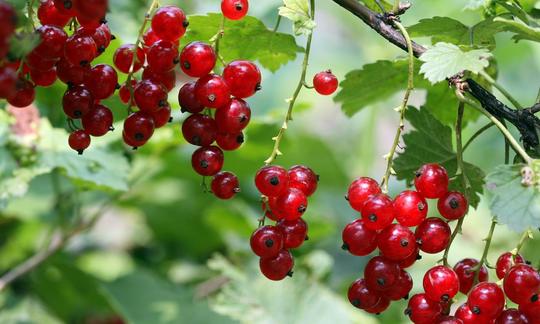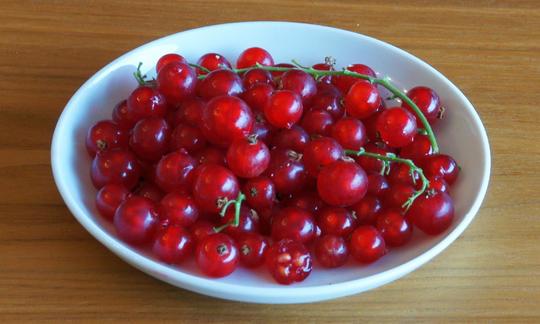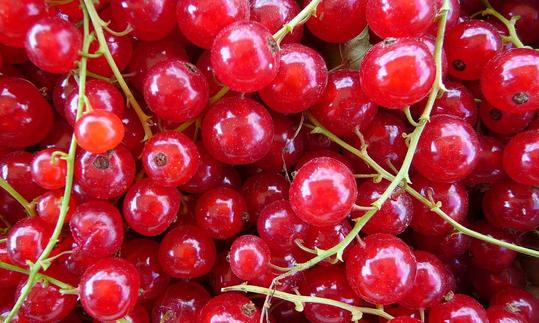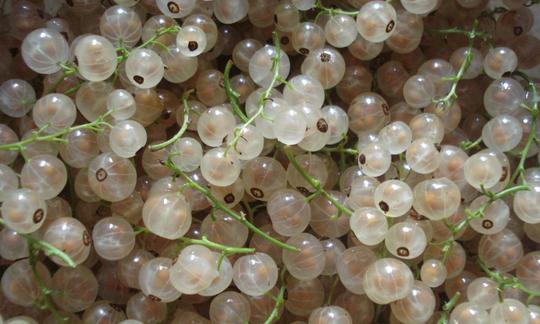Table of contents
Red Currants ( Ribes rubrum var. domesticum ) are also known as garden currants or red currants . White currants are simply a color variant of the red ones.
Use in the kitchen:
Raw currants are very popular in season as a vitamin-rich snack between meals. They also taste good in a refreshing water with lemon and mint, or their sour taste can liven up your morning muesli ( pea muesli ) or a salad.
Due to their high juice content, both varieties can be processed into jam, jelly, juice or porridge, although red currants are far more popular due to their intense color. Their high pectin content allows the processed fruit to gel well. Red currants are ideal for cakes, fruit slices or chutneys.
Blackcurrants ( Ribes nigrum ) are often used as a basis for cassis syrup.
Recipe for smoothie with red currants:
Finely blend 200 g red currants (washed) with 100 g apricots (chopped) and 200 g freshly squeezed orange juice in a high-performance blender or smoothie maker. Add a dash of lemon juice or sweetener ( agave syrup , honey or raw sugar ) to taste.
Smoothies can be varied with seasonal fruits depending on what is available. Or you can mix smoothies with rice or oat drink , which makes them a little creamier.
Making tea with currants:
Dried currants can be brewed as tea in winter. Currant leaves are also suitable for tea.
Vegan recipes with currants can be found under the note: " Recipes that have the most of this ingredient ".
| Not only vegans or vegetarians should read this: Vegans often eat unhealthily. Avoidable nutritional mistakes . |
Shopping - where to buy?
During the season, you can get red currants mainly from supermarket chains such as Coop , Migros , Denner , Spar , Aldi , Lidl , Rewe , Edeka , Hofer etc. Smaller village shops (e.g. Volg ) or supermarkets with a regional focus sell currants from the surrounding areas, so it is also possible to get white currants.
Found in the wild - Season:
The harvest time (season) of red and white currants begins in mid-June and ends around mid-August ( Swiss Fruit Association ).
A wild form of the red currant ( Ribes rubrum L. var. rubrum ) is found in Belgium, the Netherlands, France, Germany, Austria, Italy and Poland. It propagates via creeping shoots. The leaves are shiny and wrinkled on the upper side, and the berries are very small. 1
If you find the currant growing wild in the rest of Europe, it is usually a wild cultivated form ( Ribes rubrum var. domesticum WALLR.). It grows rather rarely in alluvial forests, ravines, bushes and along streams. 2
Storage:
Once you have picked the currants, you cannot store them for long. They will last a few days in the fridge. They are usually available in small cups or containers, but they are very susceptible to mold. However, the berries last a very long time on the bush. If you have a currant bush, it is best to only pick them when you need them. This way you will have fresh currants on hand for a long time. Washed and well dabbed, they can also be frozen and thawed for further processing when the time comes.
Ingredients - Nutritional value - Calories:
Blackcurrants have a calorie content of 56 kcal/100g. The main part is carbohydrates and fiber, they contain hardly any fat and only a little protein. 3
The vitamin C content is 41 mg/100g, almost as high as in lemon , which contains 51 mg/100g. Blackcurrants, in comparison, have much more: 181 mg/100g. 3
Vitamin K , a fat-soluble vitamin that is responsible for blood clotting and bone metabolism, is found primarily in green vegetables and salads. The amount in currants, for example, is not very high at 11 µg, but is still worth mentioning. Fresh parsley, for example, has 454 µg and chard 830 µg/100g of vitamin K 1 . 3
Among the vitamins in red and white currants, vitamin B 6 (pyridoxine) and folate are also mentioned as a folic acid-active substance group . 3
An important macro mineral is potassium , 275 mg are contained in red currants per 100 g. The best sources of potassium are dried herbs, legumes and nuts. For example, dried parsley contains 2680 mg, white beans 1795 mg and almonds 730 mg (/100g). In comparison, the "potassium-rich" banana has only 360 mg/100g. 3
Red and white currants also contain phosphorus , calcium and magnesium as well as traces of manganese , iron and zinc . For more information about the ingredients, see the table at the bottom after the text.
In addition to the important vitamins and minerals, the berries contain mucilage, tannins, pectin, fruit acids and flavonoids. 4
The complete ingredients of red and white currants, the coverage of the daily requirement and comparison values with other ingredients can be found in our nutrient tables. In the article Nutrients explained you will get a detailed insight into the topic.
Ratio of omega-6 (LA) to omega-3 fatty acids (ALA) in berries:
Berries and wild berries usually have a very good ratio of LA (linoleic acid) to ALA (alpha-linolenic acid) . In general, berries have a low fat content and accordingly the amounts of omega-3 and omega-6 are relatively low. In relation to the total fat content, however, the polyunsaturated fatty acids make up a high proportion.
The body uses alpha-linolenic acid to produce other omega-3 fatty acids (EPA and DHA), which have an anti-inflammatory effect, while linoleic acid is used to produce arachidonic acid, which has an inflammatory effect. The good ratio of omega-6 to omega-3 is another reason why the berries are considered a very healthy food.
Information on individual values of ALA and LA (sources: USDA, Önwt, Debinet):
Berry (raw) | L.A. (g/100g) | ALA (g/100g) | Ratio LA:ALA | Total fat (g/100g) | source |
2.6 | 1.8 | 1.5:1 | 7.1 | Önwt | |
0.6 | 0.5 | 1:1 | 1.7 | Önwt | |
0.19 0.4 0.36 | 0.09 0.3 0.26 | 2:1 1.25:1 1.3:1 | 0.34 1.0 1.0 | USDA Önwt Debinet | |
Forest Blackberry | 0.4 | 0.3 | 1.25:1 | 1.0 | Önwt |
0.2 | 0.2 | 1:1 | 0.5 | Önwt | |
0.3 | 0.2 | 1.5:1 | 0.7 | Önwt | |
0.2 0.22 | 0.2 0.15 | 1:1 1.5:1 | 0.6 0.6 | Önwt Debinet | |
0.25 0.1 | 0.13 0.1 | 2:1 1:1 | 0.46 0.3 | USDA Önwt | |
Forest Strawberry | 0.1 | 0.1 | 1:1 | 0.4 | Önwt |
Forest Raspberry | 0.1 | 0.1 | 1:1 | 0.3 | Önwt |
Boysenberry | 0.11 | 0.08 | 1.5:1 | 0.3 | Debinet |
0.11 | 0.07 | 1.5:1 | 0.26 | USDA | |
0.09 | 0.06 | 1.5:1 | 0.21 0.4 | USDA Debinet | |
0.27 | 0.05 | 5:1 | 0.4 | USDA | |
Red currant | 0.05 0.04 | 0.04 0.03 | 1:1 1.25:1 | 0.13 0.2 | USDA Debinet |
Health aspects - effects:
Red currants have numerous health benefits. They have a mild laxative, diuretic, blood purifying and digestive effect. The tannins they contain have an astringent (contracting) effect and thus protect the mucous membranes and gums. Mineral salts and vitamin C are responsible for activating the metabolism and strengthening the immune system. 4
Flavonoids and phenolic acids, together with the vitamin C contained in the fruit, prevent cholesterol deposits on the artery walls. The risk of suffering from high blood pressure or having a heart attack is lower with regular consumption.
Folk medicine - natural healing:
Freshly squeezed juice from currants is used as first aid for minor burns. 4
Occurrence - Origin:
Currants have been cultivated since the 15th century. They are found in the temperate climate regions of the northern hemisphere. According to Wikipedia , Russia, northern and central Europe had the largest world harvest in 2016.
Today, the varieties are crossed with the rock currant ( Ribes petraeum ), the spiked currant ( Ribes spicatum ) and the tassel currant ( Ribes multiflorum ). To obtain refined specimens, they are also grafted onto golden currants ( Ribes aureum ), similar to the gooseberries ( Ribes uva-crispa ).
Growing in the garden or as a pot plant:
Currants are very undemanding shrubs. They can reach a height of 1-2 m and, depending on pruning, a corresponding width.
Because of their shootiness, careful annual pruning is important for a rich harvest with larger berries.
You should also choose a sunny location that is sheltered from the wind. Currants love loose, nutrient-rich soil without waterlogging.
Currants are very easy to propagate yourself. To propagate by cuttings, cut cuttings from one-year-old shoots in winter and place them in potting soil. The 4-5 protruding "eyes" will sprout the following spring.
Another option is to bend young shoots to lower them to the ground and cover them with soil and anchor them there. The buds under the ground form new plants, which can be separated from the mother plant next year. 5
Animal protection - species protection - animal welfare:
Beekeepers use red currants as an important secondary source of nectar due to their high sugar content in the nectar (16-31%) and in the blossom (0.7 mg of sugar per day per blossom). In beekeeping, the term nectar refers to the entire supply of nectar. 2
General information:
Although red and white currants ( Ribes rubrum var. domesticum ) belong to the gooseberry family ( Grossulariaceae ), the genus of currants ( Ribes ) does not have thorns. The harvest of red and white currants begins around June 24th, St. John's Day, hence their name.
Horticultural breeding resulted in the jostaberry (josta or jochelberry). This hybrid resulted from the crossing of Ribes nigrum x Ribes divaricatum x Ribes uva-crispa (= black currant x Oregon gooseberry x gooseberry).
Alternative names:
Common names for currants in Germany are colloquially Ahlbeere, Gichtbeere, Träuble, Kanstraube or Gehonstraube. The Swiss know them as Trübeli or Meertrübeli and the Austrians say: Ribiseln.
In English, Ribes rubrum is known as red currant or redcurrant.
The name Ribes album is sometimes used for the white currant. However, this is an ambiguous name, as the World Flora Online website confirms. The name ribes rubrum (var.) alba is also in circulation.
Literature - Sources:














Comments